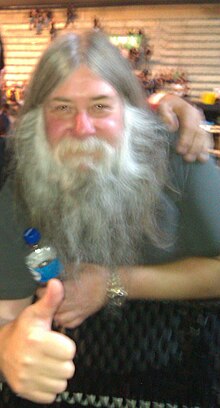Big Mick
Mick Hughes | |
|---|---|
 | |
| Born | Mick Hughes 1960 (age 63–64) Birmingham, England |
| Occupation | Audio Engineer |
| Years active | 1984 – Present |
"Big" Mick Hughes (born 1960) is the live audio engineer for Metallica, a position he has held since 1984.
He was born in 1960 and grew up in Birmingham, England. While an apprentice at British Steel Corporation, he studied electronics at a local technical college and also gained experience on the thriving Midlands music scene including working as a roadie for Judas Priest.[1] In the early 1980s, working for the PA company Techserve he engineered for bands including UB40, Dennis Brown, Yellowman, and Jungle Man before becoming the touring sound engineer for The Armoury Show, who featured ex The Skids singer Richard Jobson and ex Siouxsie and the Banshees guitarist John McGeoch.
The Armoury Show's management company QPrime then asked Mick to engineer a band they had just signed called Metallica (prompting Mick to ask "What's heavy metal?" when told the genre of music they played[2]) starting a relationship that has lasted more than 30 years.
Big Mick has mixed Metallica at every one of the more than 1500 shows they have performed since their November 1984 tour of Europe, with one exception: On the Poor Re-Touring Me Tour, Big Mick was hospitalised with heart palpitations. Michael J "Geese" Graphix, Audio System Engineer for Electrotec and mix engineer for such acts as Guns N' Roses and Nine Inch Nails, stepped in and mixed FOH for two shows: 24 July 1998 in Antioch, Tennessee and 25 July 1998 in Noblesville, Indiana. Big Mick recovered and continued his reign at the Metallica helm. His contract with Metallica supposedly states that he has to be called by his moniker, although amongst the band themselves he is known as Full Roar.[3]
The live mixing technique he is often credited with is adding a high mid "click" to the bass drum, which evolved early on with Metallica as a means of lifting Lars Ulrich's bass drums out of the bottom heavy sound.[4] A more recent crusade is to encourage engineers to start soundchecks with ambient microphones (such as vocal microphones) working through to close-miked or gated instruments such as drums. This is in direct opposition to the usual soundcheck which starts with the kick drum and ends with the vocals, but actually makes a lot of sense since the final sound of any instrument is going to be the combination of the ambient and close microphones it can be heard through.
When not busy with Metallica, he has also worked with Halford, Ozzy Osbourne, Def Leppard, Queens of the Stone Age and Steve Vai. He produced the album World Service for the rock band Radio Moscow in 1991.[5] He managed The Wildhearts in the 1990s and has worked with them live [6][7][8] and in the studio [9] since their reunion in 2002. After Metallica, the band he is most strongly associated with is Slipknot,[10] who he has worked with between Metallica tours since 2001. He has even done sound for a Slipknot tribute act, Slip-not.[11]
In 2007, he was asked to mix the FOH sound for the Led Zeppelin reunion concert[12] at London's O2 Arena in conjunction with Robert Plant's personal vocal mixer Roy Williams. They used the facilities of the Midas XL8 digital mixing console to allow them to do this on a single desk.[13] He consciously did not use the clicky Metallica bass drum sound, preferring instead to update Jason Bonham's ambient and reverberant drum sound by using a mix of close and ambient drum microphones on his kit,[14] brought into phase using a 3 or 4ms delay,[15] and finished with a small amount of digital reverb.
References
- ^ "ProSoundWeb – When "Big Mick" Talks, Sound Engineers Ought To Listen!". 11 August 2001. Archived from the original on 11 August 2001. Retrieved 20 August 2018.
- ^ "A conversation with Big Mick Hughes, Front-of-House Engineer for Metallica". Audio-Technica. Retrieved 20 August 2018.
- ^ "James Hetfield interview – "We call him Full Roar for a reason. He turns those faders up and doesn't stop."". Archived from the original on 19 December 2016. Retrieved 20 August 2018.
- ^ Big Mick discusses the evolution of the drum sound Archived 22 September 2007 at the Wayback Machine
- ^ "MusicMight :: Artists :: RADIO MOSCOW". 15 August 2016. Archived from the original on 15 August 2016. Retrieved 20 August 2018.
- ^ Really1980 (9 June 2007). "Roadies 2 – On The Road Again (The Wildhearts) [Part 1]". Retrieved 20 August 2018 – via YouTube.
{{cite web}}: CS1 maint: numeric names: authors list (link) - ^ Really1980 (9 June 2007). "Roadies 2 – On The Road Again (The Wildhearts) [Part 2]". Retrieved 20 August 2018 – via YouTube.
{{cite web}}: CS1 maint: numeric names: authors list (link) - ^ Really1980 (9 June 2007). "Roadies 2 – On The Road Again (The Wildhearts) [Part 3]". Retrieved 20 August 2018 – via YouTube.
{{cite web}}: CS1 maint: numeric names: authors list (link) - ^ "The Wildhearts – Coupled With". Discogs. Retrieved 20 August 2018.
- ^ Bozza, Anthony (11 October 2001). "Slipknot: Highway to Hell". Rolling Stone. Retrieved 20 August 2018.
- ^ August 2006 entry on Viper Productions news page Archived 26 June 2010 at the Wayback Machine
- ^ Definitive article on the production of the Ahmet Ertegun tribute Archived 17 July 2011 at the Wayback Machine from Total Production International magazine. Archived 21 August 2010 at the Wayback Machine
- ^ "MIDAS – MUSIC Tribe". www.midasconsoles.com. Archived from the original on 4 September 2012. Retrieved 20 August 2018.
- ^ Details of microphones used at the Led Zeppelin reunion Archived 7 July 2011 at the Wayback Machine
- ^ Article in the June 2008 issue of Performing Musician And Live Sound World magazine (not online)
